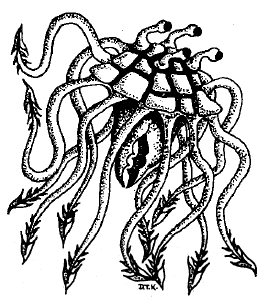Belabra
Created by Ed Greenwood
Art by Dennis Kauth

-
FREQUENCY: Rare
NO. APPEARING: 1
ARMOR CLASS: -2 (?head?);
6 (tentacles)
MOVE: 4?/7? (hop) (MC: E)
HIT DICE: 4 + 4
% IN LAIR: 10%
TREASURE TYPE: Nil
NO. OF ATTACKS: 1 bite or 1 ram
DAMAGE/ATTACK: 3-12 or 2-8
SPECIAL ATTACKS: Entangling;
barbed tentacles
SPECIAL DEFENSES: Blood spray
MAGIC RESISTANCE: Standard
INTELLIGENCE: Low
ALIGNMENT: Neutral
SIZE: M (tentacles 5? long)
PSIONIC ABILITY: Nil
Attack/Defense Modes: Nil
LEVEL/X.P. VALUE: V/250 + 5/hp
The belabra, or "tangler," is as valued
among merchants and other travelers
as it is
feared in the wild. Though it is a carnivore,
it can be trained to entangle and hold creatures
captive at its master?s command without
harming its victims.
The belabra earns its nickname for its
twelve tentacles, which it uses to capture its
meals. Each tentacle grips and holds securely
but does no damage unless the victim
tries to pull free. (Escape requires the victim
to roll his chances to bend bars or lift gates;
one such attempt may be made per round.)
Barbs on the tentacles holding the struggling
victim will then do 3-6 points of damage.
In the wild, a belabra pounces upon
victims, holds them doggedly, and can then
bite repeatedly until only the victim?s skeleton
is left. A belabra?s bite does 3-12 points
of damage, and its white stomach expands
to take in what is eaten. A belabra can
easily devour creatures much larger than
itself.
A belabra moves by crawling along the
ground with its tentacles or by bounding
into the air, beating its tentacles once with a
sharp clap and snapping them out behind it
to serve as a rudder. By the latter method it
can glide up to 7? in still air (more if descending
from a height or riding strong aircurrents).
At any point in its glide, the belabra can
whip its tentacles about a target and plummet
earthward. Falls do only 1 hp of damage
for every 10 feet fallen to the rubbery
belabra, so this attack method is often used.
A belabra in combat bounds about, seeking
to keep its armored head between its
opponent and the vulnerable tentacles, until
all twelve can lash out at once to entangle
the opponent. Entangling occurs if the
belabra successfully hits against an opponent
as a 9 HD monster. The victim then
loses all dexterity bonuses for armor class
and the belabra may bite at the victim with
a +4 bonus to hit. The tentacles are quite
dextrous; belabras have been known to
open doors, delve into cages or sacks, and
saw through nets with their barbed tentacles.
A favored attack is the ram, in which
the belabra springs or glides forcibly into an
opponent, striking with its armored head.
This does a jarring 2-8 points of damage if
it hits.
The belabra hunts by scent and sight. Its
four eyes are mounted on retractile stalks
projecting from its armored head, and its
olfactory organs are located under the rim
of the armor. Both sets of organs and the
armored head are AC -2; the white, rubbery
tentacles are AC 6, and they may only
be attacked when the belabra has entangled
a victim. However, injured tentacles spray
whitish blood that blinds and causes sneezing
in humans, halflings, and elves (all
within 1? must save vs. poison at -3 to
avoid effects). Victims so affected make all
attacks at -4 ?to hit? and have their armor
class reduced by 2 ranks for 3-24 rounds.
The belabra is surprisingly light for its size,
weighing from 60-80 gp (6-8 pounds) when
its stomach is empty.
A belabra can be trained to obey the
verbal commands of a master, hunting and
immobilizing or killing like a trained dog or
falcon. It can also aid its master in battle
(95% loyalty in dangerous situations, 100%
otherwise). Such training is a skill, and
good trainers require 4-16 weeks to train a
captured belabra, given a secluded training
area, a large supply of live animals to serve
as training kills and food, and access to the
person the belabra is being trained by (for 4
consecutive hours per day). Poor trainers,
unfavorable conditions, or constant interruptions
will lengthen the training period.
Belabra young, if raised for 2 years, will
obey many commands and will pause before
devouring entangled prey as a matter of
course.
Belabra young gestate for 6-10 months in
a sack formed within the stomach of the
parent. It seems that belabras have only one
sex, so any belabra can carry an offspring.
Belabras are otherwise solitary. Captured
belabra young may bring as much as 4,500
gp on the open market.